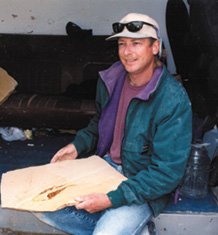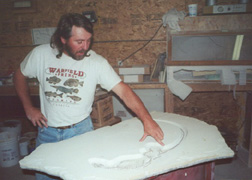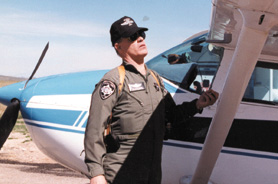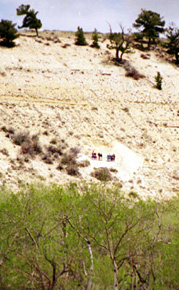
Charlie Nunn displays a well-preserved fossil
from the back of his van. CR
| Home | Calendar | Classifieds | Subscribe | Advertise |
| Geotimes
Published by the American Geological Institute |
Newsmagazine
of the Earth Sciences
October 2000 |
|
by Christina Reed and Laura Wright LW
|
At 16 he worked for a local quarry owner, Rick Hebdon, splitting rock layers dotted with two-inch Knightia fish that tourists can buy for $10. “I started working for Rick back in 1987,” he says. “What I did on the side was illegal.” Nunn knew where he could find prized fossils on private land, but he didn’t ask for permission to dig first. Then in 1995, he sold a fossil feather to an undercover officer from the Bureau of Land Management (BLM) for $700. But that didn’t land him in jail.
It was later, when Nunn sold a half-ounce of marijuana to an undercover officer working with the local sheriff’s department, that he was arrested. “They were originally after me for the fossils, because they knew I had done it my whole life here. In the end they dropped the two fossil felonies and stuck me with the delivery, the marijuana.”
The drug charges ended Nunn’s secondary career as fossil thief. “Now I’m strictly legal,” he says. “You don’t want to mess around and dig out in this country; you’ll go to jail quick.” Today Nunn runs a successful business doing what he loves. He leases a quarry from a private rancher on the other side of the hill from Hebdon. “This quarry has been here for eight years. I took over from the previous owner three years ago. It’s a private lease from a private rancher. I don’t have to deal with the state and I get to keep everything. So it’s a good set up now,” he says.
| Protected by the same laws that failed to convict him, Nunn works in a business where legal loopholes are plentiful. For example, it is illegal to sell anything from BLM land but a collector can take up to 250 pounds of petrified wood for personal use each year. If the state of Wyoming leases a quarry to a fossil hunter who then finds a stingray, gar fish or paddlefish, the finder can sell the fossil but must report the find to the state and pay the state royalties from the sale. If the collector comes across a turtle, crocodile or bat she must turn it over to the state within 30 days for review. The same fossil found on private land, like Nunn’s or Hebdon’s quarries, could end up just as easily in a shopping mall in Japan as in the home of a private collector in Italy without state scientists ever learning about it. Unless a thief is caught in the act of stealing from private or public land, law enforcement officials face a daunting task of matching the matrix surrounding the fossil to its place of origin and evaluating paper trails. | 
Charlie Nunn displays a well-preserved fossil from the back of his van. CR |
|
fossil collecting regulations. |
With the different rules on fossil collecting also comes a variety of views on how paleo resources should be managed. Scientists are concerned that rare fossils can be stolen from under their noses. Private collectors grapple with laws because they often believe someone needs to collect the fossils eroding out of the ground before they wash away and are lost to everyone. Law enforcement officers, such as National Park Service rangers, are trying to preserve fossils in their geologic context for future generations and to prevent fossils from theft — while still allowing access for scientists. |
Lost to science
“Things are stolen faster than we can dig them up,” says Jim Kirkland, state paleontologist of Utah. In April, scientists from the College of Eastern Utah (CEU) Prehistoric Museum in Price discovered looters had destroyed, in probably a day’s work, almost a third of a remaining stegosaur skeleton that the scientists had spent years painstakingly excavating. The scientists rely on slow-going equipment — diamond saws, airscribes and brushes. The thieves cut out the bone with quick and clumsy instruments — hammers, chisels and large pry bars — vandalizing and destroying much of the skeleton in the process, says John Bird, dinosaur bone lab manager for the CEU museum.
Plant eaters with small, flat teeth and a brain the size of a walnut, stegosaurs are famous for their ridge of armored plates running down their spines. Scientists know of a handful of complete stegosaur skeletons, and only four partial skeletons have been found in Utah. “It would have been a good comparison specimen, but now we’ll have to wait until somebody finds another one,” Bird says. The thieves struck gold in an isolated area. The museum has over 50 sites, and the stegosaur lies at a site in Emery County that requires a four-wheel-drive vehicle and then good pair of boots to hike over two hills. After assessing the damage, Bird estimated the scientists were only a couple weeks from finishing the job.
But at least the museum still has the contextual knowledge of where the stegosaur was found, along with a few other bones, he says. “Most people who vandalize do it innocently, they don’t know it’s illegal. But they can cause scientific damage if they collect. We lose a lot of information that way.” He believes education of the public is essential. If someone finds a fossil he suggests marking the location on a map and taking pictures. “Don’t pick it up,” he says. Instead, Bird asks people to take the information to a local museum or college. The best way amateurs can help, he says, is by “keeping their eyes open” and volunteering with clubs such as Utah Friends of Paleontology to collect with professionals.
“Still, there is always that one person who wants to make money,” Bird says. On the market even incomplete dinosaur skeletons can sell for thousands, let alone a complete specimen. Sotheby’s sold “Sue,” the T-rex now at the Chicago Field Museum, for $8.4 million in 1997. Forbes reported in June that the small-time collectors of $2 shark teeth and $40 duckbill dinosaur finger bones support a $50 million (annual) business. Butterfields, an eBay company, sold a 200 million-year-old icarosaur titled “A Unique and Important Flying Reptile Fossil — The Origin of Vertebrate Flight Before Birds!” during its Aug. 27 Natural History Auction for $172,500. Alfred Siefker first found the fossil in 1961 when he was 17 and lent it to the American Museum of Natural History in New York. But 10 years ago he reclaimed the fossil. Now 56 and ill, Siefker put it up for auction to raise money. The buyer, a “friend of the museum,” plans to return the fossil to the American Museum of Natural History. The Butterfields auction also brought in $10,350 for “A Huge Fearsome Claw from the ‘King of Dinosaurs,’” along with $6,325 for an Allosaurus claw, $4,025 for T-rex foot bones and $690 for a T-rex toe.
A
confused fossil
| “This is private ground and this is America,”
Rick Hebdon says. He can sell anything he finds from Warfield Fossil Quarries,
one of the three quarries he leases and manages on private land in the
Green River Formation of Wyoming. “It’s legal to sell stingrays when they’re
found on private ground,” Hebdon says. And he’s right.
Conversely, Shirley and Carl Ulrich, owners of Ulrich’s Fossil Galleries, lease their land in the Green River Formation from the state of Wyoming. Should they come across a stingray or other rare specimen, such as turtles or the prized gar fish that can reach five and-a-half feet, they are required by law to notify the state of their discovery. The gars and the turtles they must turn over to the state for review, but the stingrays they can sell without the state collecting the contextual knowledge that comes from reviewing the matrix surrounding the fossil’s original location. |

Back in his workshop, private fossil collector Rich Hebdon points out carefully prepared fossils excavated from his Warfield Springs quarry. LW |
But the laws on sales do not help a buyer determine
whether a fossil came from state, public or private land. Several years
ago, Hebdon found a well-preserved stingray in his Warfield Springs quarry,
just north of Kemmerer, that he sold unfinished to a fossil dealer from
Trieste, Italy, for $1,000. The Italian buyer, Flavio Bacchia, cleaned
the fossil and prepared it for sale. He then put the stingray up for consignment
with Glenn Rockers, a dealer who took it to the 1996 Tucson Gem and Mineral
Show and displayed it for sale at $4,500. An undercover police officer
posed as a fossil collector was at the Tucson show on the lookout for stolen
fossils. He spotted the stingray and was suspicious of its origins.

Sgt. Steve Rogers inspects his plane before taking off to patrol southwest Wyoming from the sky. CR |
The undercover officer was Sgt. Steve Rogers of the Lincoln County Sheriff’s Department in Kemmerer. National Geographic Television traveled to the Tucson show with Rogers while he recorded his undercover sting operation using hidden cameras. He was suspicious of the fossil because he recognized it as a species unique to the Green River Formation that he patrols by airplane where public, private and state land crisscross the map. When he asked Rockers the fossil’s origin, the dealer replied: “Comes out of Kemmerer — one of the fish quarries there on state land.” Rogers, who believed he was hot on the trail of a stolen fossil, arranged to meet Rockers later to purchase the fossil. If the fossil had been stolen from public land, it would be illegal for Rockers to sell it. And that is where Rogers thought he’d get his man. |
Rockers misinformed Rogers when he said that the fossil was collected on state land. It was indeed collected in the state of Wyoming and in Lincoln County, where Rogers patrols. But the state court of Wyoming determined in May 2000 that Rick Hebdon legally quarried the ray at his private quarry. The stingray traveled from Wyoming to Italy and from Italy to Tucson without a hitch. But from there it made its way back to Lincoln County, Wyo., wrapped in red tape.
The ray landed in the evidence vault in the Lincoln County Sheriff’s Department while law enforcement officers attempted to determine where it was originally found. To do so, they conducted analyses of the matrix around the ray and compared the data with matrix data from various quarries and other public lands from around the region. Until recently, officials thought the fossil was removed from state land. Following the trail of official documents and receipts that were produced by each successive sale of the ray, the courts were able to trace it back to Hebdon, its original owner. After much difficulty and finger pointing, the ray was returned to Hebdon.
Protecting the resource
Only miles away from Hebdon’s and Nunn’s quarries, and almost within earshot of the Ulrich quarry, lies Fossil Butte National Monument. The National Park Service established the monument in 1972 to preserve the fossilized remains of Fossil Lake — a shallow, 930-square-mile lake that existed for 2 million years during the Eocene. It was the three-lake system of Fossil, Uinta and Gosiute that produced the fossil-rich sediments that characterize southwest Wyoming.
Fossil Butte is a small national park where visitor
counts reach only about 27,000 per year — compared to Yellowstone’s 4 million
yearly visitors. Few permits are granted for research and fossils
are the park’s most valuable natural resource. The rangers who work at
Fossil Butte are looking for ways to stop fossil theft.
| Park Ranger and paleontologist Vince Santucci
says tourists should have the chance to experience the excitement of discovering
a fossil so that they won’t feel compelled to visit other sites and remove
specimens unsupervised. Fellow ranger Aarvid Aase, a paleontologist and
National Park Service museum technician who is also familiar with commercial
quarrying, established and operates a small scientific quarry at Fossil
Butte where he takes visitors for supervised “digs.” During the digs visitors
do not actually split rocks on their own, they observe as Aase excavates
specimens to catalog them in the park’s ongoing inventory of paleontological
resources.
The Fossil Butte program is one of the preventative measures that park rangers can take to stop fossil theft. Santucci realized the importance of the visitor’s personal experience when he was a seasonal park ranger at Badlands National Park in South Dakota. He saw how excited the first-time visitors were when they came upon a fossil for the first time. “They’d look around and crawl around and maybe they’d find a tooth. To them, that is their personal discovery. Their T-rex. They remember that. They photograph it, and I think that a lot of those folks will have that picture in their minds for a long time, that personal experience.” He compares it to the thrill of watching a bald eagle dive down and catch a fish. “That’s yours, that’s your personal encounter. Their personal encounters with these fossils in the field are really valuable. We use that as an inspirational way to let visitors know that this is really cool. That maybe it is worth leaving these fossils here to share with other visitors.” |

A group of schoolchildren watch paleontologists inventory fossils at the visitor's quarry at Fossil Butte National Monument. LW |
The freedom to establish new programs to educate visitors and rangers at other national parks is one of the few powers that paleo-aware rangers such as Santucci and Aase have. Their power to prosecute those who violate the NPS laws is limited. Petty thieves, if caught, sometimes get away with little more than a small fine. As government employees, rangers cannot be soapbox advocates for stricter fossil regulations. So they are left to find other ways to prevent the loss of scientifically valuable fossils.
Teaming up: geologists and park rangers
The NPS has come a long way since 1986 when it first held a conference on the management of paleontological resources in national parks. Since then, it has held five more conferencesand started collecting scientific data on fossil resources in all park lands. Scientific reports may tell paleontologists a lot about the value of fossil resources in a particular location, but they may as well be written in Greek as far as most park rangers are concerned.
Rangers, with many different responsibilities
on large tracts of land, have little time for science. To help, rangers
like Santucci are teaming up with paleontologists to produce reports that
will help park rangers monitor and protect fossil-rich sites with little
more geologic knowledge than is required to read a topographic map, which
most can already do.
With so much fossil-rich land and so few
eyes to patrol it, creating paleo-aware rangers is one of the steps the
park service can take to prevent fossil theft, short of exponentially increasing
the number of rangers, Santucci says.
Seeing all sides
Three major camps call out to be heard on who
should have the right to fossil collection, sale, research and preservation.
On one side are the private collectors, who believe they are acting as
the fossils’ heroes by extracting them from the ground before they are
eroded away, never to be seen by human eyes. Hebdon says, “If they aren’t
preserved then they’re washing out of the ground into the ocean. How are
we preserving anything if we just let it rot in the ground?”
| Scientists argue that rare specimens
are slipping away to dealers and collectors, lost to science. A unique
specimen, even when perfectly finished and displayed, is “little more than
sculpture when taken out of its geologic context,” Kirkland says.
Then there are law enforcement officers who believe the issue boils down to right and wrong: Public property belongs to no one person. It should be preserved and shared for all. “We need to be monitoring and making sure that fossils are not weathering away on one side, but on the other side, these are public resources,” Santucci says. “No individual has the right to go in and remove them and sell them. They are ripping off science and the public.” As a police officer, Rogers sees the issue as very clear-cut. “If it’s not yours, you have no right to take it,” he says. Even if the involved parties reach a consensus, the question remains over how to enforce the any one policy. Private collectors who break the law will continue to do so, Santucci says, “It’s too lucrative. It’s too easy.” For both law enforcement agents and scientists, one of the overwhelming problems is that too few eyes are monitoring the millions of acres of fossil-rich public land. As with the case of the stolen stegosaur, it is not that difficult to haul off even the largest specimens without anyone ever knowing when it actually happened, let alone by whom. Paleo-aware rangers like Santucci hope that educating rangers at all national parks will help previously unaware rangers prevent sites from being looted. But some scientists are less optimistic. “Monitoring the sites is done,” Kirkland says. “We’re going to lose the Mona Lisa trying to get one conviction.” To Kirkland, catching one thief red-handed is not enough. He says the only way to reduce the impetus to steal rare fossils from anywhere is by tightening the regulations on the import, export and sale of fossils. John Bird agrees. “The biggest problem is the sale of dinosaur bones in rock shops,” he says. “If people did not buy the bones the market would dry up. Realistically though, I don’t think that will happen.” In 1999, Congress mandated that all federal land management agencies compile a comprehensive report on the management of fossils on federal and Native American lands. Secretary of the Interior Bruce Babbitt presented that report to Congress in May 2000. In it he implored policy-makers to enact laws similar to those that protect archaeological resources, where penalties are stiffer and research and conservation are deemed valuable for cultural and scientific progress. The report outlines some of the problems that arise when fossil collectors, scientists and law enforcement officers all grapple with laws that are vague. But the blood that boils over personal disagreements cannot be portrayed in a report to Congress. What the report has tried to illustrate for policy-makers is the need to “move forward and make certain that inattention does not deprive us of the best information we will ever have about our deepest past.” |
Where
am I now, and can
I take this fossil with me? The
rules governing the removal of fossils from a particular location vary
according to the agency that controls the land where the fossil is found.
Even if the fossiliferous find is only a broken bivalve, it might be illegal
to pocket it and walk away. When traveling out West — where the checkerboard
of private, state and federal lands seems endless — a fossil collector
must be wary of the soil upon which he treads and, more to the point, digs
for fossils.
Federal land
Bureau
of Land Management
National
Park Service
U.S.
Forest Service
Bureau
of Reclamation
U.S.
Fish and Wildlife Service
Obtaining a scientific permit for collecting on federal land generally requires a graduate degree in paleontology or a related field. Reports must be filed with the permitting agency annually and at the end of the project. Permits can vary from limited surface collection and surveying to the excavation of one square meter or more of sediment. State land
Private land
Laura Wright |
 |
Geotimes Home | AGI Home | Information Services | Geoscience Education | Public Policy | Programs | Publications | Careers |